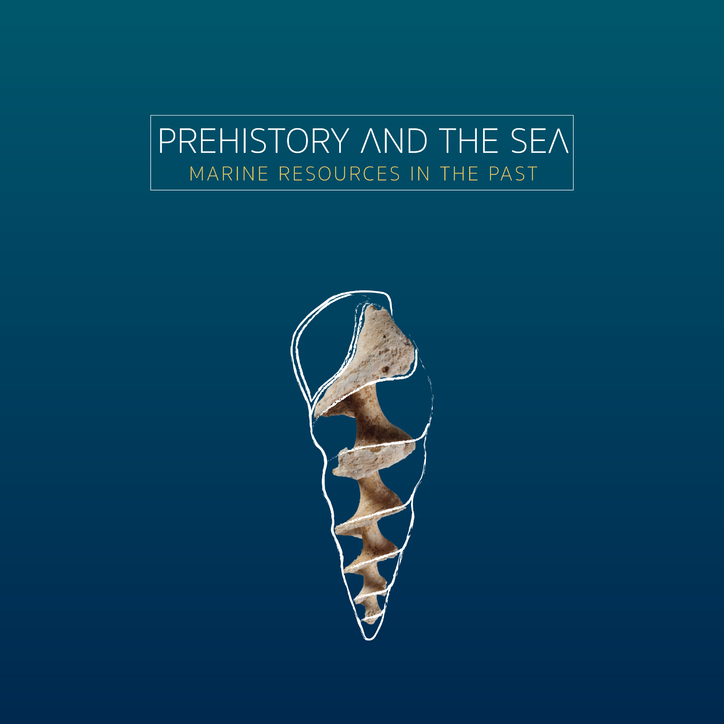La Prehistòria i la Mar

2025
Triptic
[page-n-1]
V
MARINE RESOURCES IN THE PAST
V
PREHISTORY ND THE SE
[page-n-2]
This exhibition presents the results of recent
research into the use of marine resources on the
Mediterranean coastline of Spain in prehistoric times.
It comprises more than a hundred exhibits from a
dozen sites in the region of Valencia, preserved today
in the city’s Museum of Prehistory. The pieces date
Pendant. Mimachlamys varia. L’Hort de Cortés-Volcán del Faro. Upper Palaeolithic.
back between 30,000 and 3,000 years.
Very little is known about the use of marine products
as sources of nutrition during the Upper Palaeolithic.
The coastal deposits are currently under water, due
to the flooding of the coastal platforms after the
sea level rise of the end of the glacial period. Ten
thousand years ago, during the Mesolithic period,
molluscs such as cockles, limpets and snails, and
fish such as bream, rays, mullet and meagre were
Ichthyological remains. El Collao. Mesolithic.
all consumed. Interestingly, these marine products
have been found in deposits more than 40 km from
the coast, thus confirming the use of preservation
systems such as drying in the sun or smoking.
Their shells were used for decorative purposes,
or as containers, or as smoothers and scrapers.
Other shells were used to make spoons, ladles,
needles and musical instruments (conches), and the
vertebrae of cetaceans were used as work benches
Scallop spoons. Ereta del Pedregal and Sanxo Llop. Chalcolithic.
[page-n-3]
or anvils. Shells were also used to manufacture
Whale rib with signs of wear.
Sanxo Llop. Chalcolithic.
personal adornments. The display features
the manufacturing processes of three types of
adornment: discoidal beads, bow-shaped pendants
or buttons, and oval pendants.
From the Neolithic onwards, more elaborate
ornaments were made: in the early Neolithic
oval pendants, rings and bracelets, and from
Chalcolithic times discoidal buttons and beads.
Fish vertebrae, from rays and sharks, were also
used. Many of the ornaments may have had
symbolic value, often associated with the funerary
world: examples are the shells recorded in burial
caves dating from 5,000 years ago, which had not
been perforated or manipulated.
An exceptional finding is the presence of a
Gibberula miliaria shell necklace.
Cau Raboser. Chalcolithic.
bottlenose dolphin deposited in a secondary burial
located in a grave near the mouth of the Serpis.
This is a unique event – the only cetacean ever
found in a funerary context.
In summary, then, the exhibition reveals to us the
wide variety of uses that prehistoric societies made
of marine resources.
Bottlenose dolphin skeleton during excavation. Sanxo Llop. Chalcolithic.
[page-n-4]
TRESORS
DEL MUSEU
DE PREHISTÒRIA
Corona, 36. 46003 València · www.museuprehistoriavalencia.es
Tel: +34 96 388 35 65. Follow us on
Cerithium vulgatum, very rolled. Sanxo Llop. Chalcolithic
MUSEU DE PREHISTÒRIA DE VALÈNCIA. JUNE - NOVEMBER 2021
[page-n-5]
V
MARINE RESOURCES IN THE PAST
V
PREHISTORY ND THE SE
[page-n-2]
This exhibition presents the results of recent
research into the use of marine resources on the
Mediterranean coastline of Spain in prehistoric times.
It comprises more than a hundred exhibits from a
dozen sites in the region of Valencia, preserved today
in the city’s Museum of Prehistory. The pieces date
Pendant. Mimachlamys varia. L’Hort de Cortés-Volcán del Faro. Upper Palaeolithic.
back between 30,000 and 3,000 years.
Very little is known about the use of marine products
as sources of nutrition during the Upper Palaeolithic.
The coastal deposits are currently under water, due
to the flooding of the coastal platforms after the
sea level rise of the end of the glacial period. Ten
thousand years ago, during the Mesolithic period,
molluscs such as cockles, limpets and snails, and
fish such as bream, rays, mullet and meagre were
Ichthyological remains. El Collao. Mesolithic.
all consumed. Interestingly, these marine products
have been found in deposits more than 40 km from
the coast, thus confirming the use of preservation
systems such as drying in the sun or smoking.
Their shells were used for decorative purposes,
or as containers, or as smoothers and scrapers.
Other shells were used to make spoons, ladles,
needles and musical instruments (conches), and the
vertebrae of cetaceans were used as work benches
Scallop spoons. Ereta del Pedregal and Sanxo Llop. Chalcolithic.
[page-n-3]
or anvils. Shells were also used to manufacture
Whale rib with signs of wear.
Sanxo Llop. Chalcolithic.
personal adornments. The display features
the manufacturing processes of three types of
adornment: discoidal beads, bow-shaped pendants
or buttons, and oval pendants.
From the Neolithic onwards, more elaborate
ornaments were made: in the early Neolithic
oval pendants, rings and bracelets, and from
Chalcolithic times discoidal buttons and beads.
Fish vertebrae, from rays and sharks, were also
used. Many of the ornaments may have had
symbolic value, often associated with the funerary
world: examples are the shells recorded in burial
caves dating from 5,000 years ago, which had not
been perforated or manipulated.
An exceptional finding is the presence of a
Gibberula miliaria shell necklace.
Cau Raboser. Chalcolithic.
bottlenose dolphin deposited in a secondary burial
located in a grave near the mouth of the Serpis.
This is a unique event – the only cetacean ever
found in a funerary context.
In summary, then, the exhibition reveals to us the
wide variety of uses that prehistoric societies made
of marine resources.
Bottlenose dolphin skeleton during excavation. Sanxo Llop. Chalcolithic.
[page-n-4]
TRESORS
DEL MUSEU
DE PREHISTÒRIA
Corona, 36. 46003 València · www.museuprehistoriavalencia.es
Tel: +34 96 388 35 65. Follow us on
Cerithium vulgatum, very rolled. Sanxo Llop. Chalcolithic
MUSEU DE PREHISTÒRIA DE VALÈNCIA. JUNE - NOVEMBER 2021
[page-n-5]
Back to top